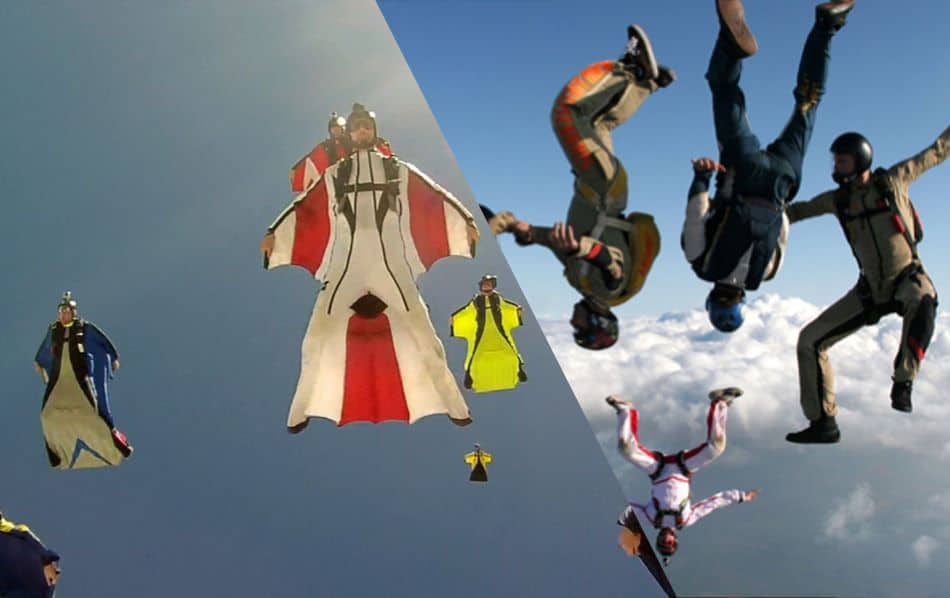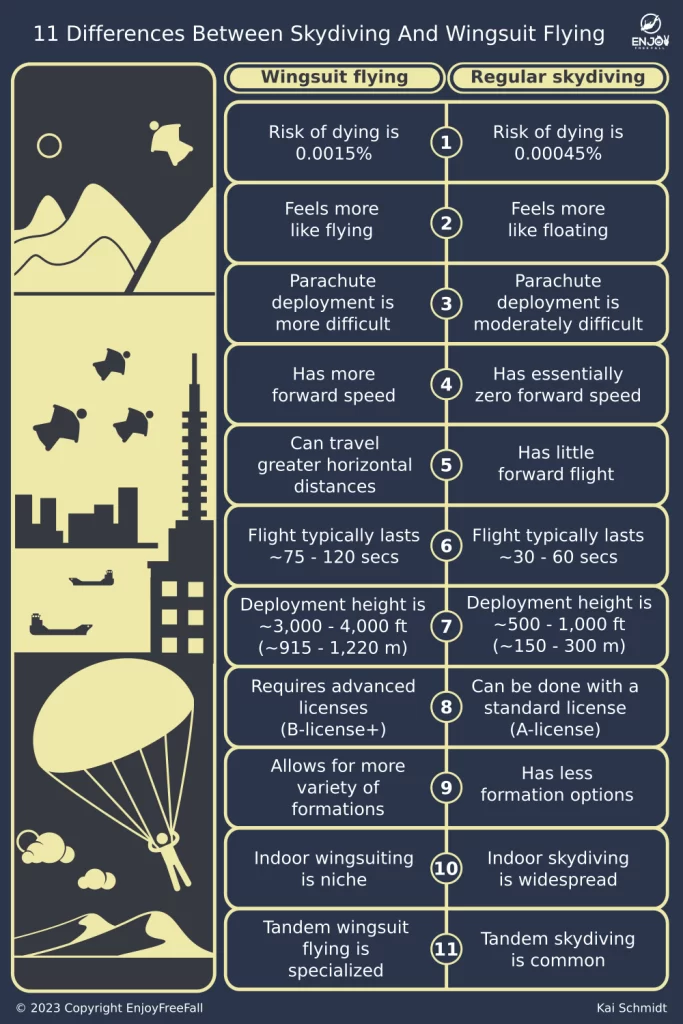
Even though wingsuit flying is a specialized discipline of skydiving, people often view it as a separate sport. While both sports involve jumping from a plane or other high altitudes, there are significant differences between the two experiences that make each unique.
In this blog post, I will explain all differences between wingsuit flying and normal skydiving. I will also uncover common misconceptions about both sports.
Wingsuit Flying Is More Dangerous Than Regular Skydiving
Wingsuit flying is 3.2 times more dangerous than regular skydiving in terms of fatalities. The fatality rate of wingsuit flying is 0.0015% i.e. one fatality for every ~70,000 jumps whereas the fatality rate for regular solo skydiving is 0.00045% i.e. one fatality for every 220,000 jumps.
However, wingsuit flying is 18 times safer in terms of injuries, that require medical attention. In regular skydiving, one injury happens for every 2,000 jumps (0.05%) whereas in wingsuit flying one injury occurs for every 37,000 jumps (0.0027%).
Wait what? How can wingsuit flying be more dangerous in terms of fatalities but safer in terms of injuries?
On average, wingsuit flying is more dangerous than regular skydiving due to the higher speeds and greater risk of collision with objects. Flying at high speeds in a wingsuit means that the margin for error is much smaller, and even a small mistake can have severe consequences.
In addition, wingsuit pilots are more prone to collisions with objects such as cliffs, trees, or other skydivers.
However, despite the higher risk of fatality in wingsuit flying, there are fewer injuries reported compared to regular skydiving. This is because wingsuit pilots are very experienced skydivers. They need to have at least 200 regular jumps under their belt before even starting wingsuit flying.
This means that there are no “true beginners” in wingsuit flying. The biggest risk in skydiving is the landing process, in which most injuries happen. Beginners often struggle with the landing and might hurt themselves, bringing the injury statistics up.
As even novice wingsuit pilots are already familiar with the landing process, they are less likely to make mistakes.
Are looking to learn more about the adrenaline-fueled world of wingsuit flying? My latest post covers the exciting topic of landing procedures, debunking common myths and misconceptions.
Wingsuit Feels More Like Flying Than Regular Skydiving
As a general rule, wingsuit pilots have more control over their flight trajectory than regular skydivers. The wings and the large surface area allow wingsuit pilots to change their glide ratio and flight direction to a greater extent than in regular skydiving.
Novice wingsuit flyers often report that flying a wingsuit feels much more like flying than regular skydiving. It gets closer to being an actual bird.
One notable difference is the direction of the wind. In wingsuit flying the wind comes diagonally from the front rather than from below, depending on the body position. This can create a quieter experience but also makes it more difficult to communicate with others during the flight.
In addition, wingsuit flying is less stable than traditional skydiving, especially for beginners. The wingsuit’s large control surfaces mean that even small movements can result in significant inputs, requiring smooth and subtle adjustments. If movements are made too fast, the wingsuit pilot can overshoot and start spinning around.
However, with practice and experience, the body will learn to compensate and adjust to the wingsuit’s unique flight characteristics.
Another significant difference is the burble, which is the area of dead or turbulent air on your back created when falling. In wingsuit flying, the burble is behind the pilot, allowing for unique vertical formations that are not possible in other skydiving disciplines.
That being said, wingsuit flying and regular skydiving offer both a unique and adrenaline-fueled experience that many people never forget.
Deploying The Parachute During Wingsuit Flying Is More Difficult
Opening a parachute while wearing a wingsuit is more challenging than during a normal skydive due to the nature of the wingsuit itself. The wingsuit is a large, fabric suit with wings on the arms and legs that allow the pilot to glide through the air. When the parachute is deployed, the wingsuit can create additional drag and instability, making it more difficult to control the parachute’s deployment and landing.
The wingsuit flyers also need to change their position before opening the parachute. They need to reduce their forward speed by the so-called “flaring”. During flaring, they will bring their body in a more vertical position which increases the surface area with the “forward” air. This creates more air resistance and reduces the forward speed.
This maneuver is not as easy as it sounds. If wingsuit flyers have too much forward speed when opening the parachute, the parachute might not properly open. In some cases, the wingsuit can even become entangled with the parachute, creating a dangerous situation for the pilot.
Last but not least, because the wingsuit covers much of the pilot’s body, it can be more challenging to access the parachute’s deployment handles and complete the necessary safety checks before deployment. This means that wingsuit pilots must be even more vigilant and precise in their movements during the deployment process.
Wingsuit Flyers Have More Forward Speed Than Regular Skydivers
As a general rule, the forward speed of wingsuit skydivers is faster than that of regular skydivers. On average, skydivers reach a forward speed of around 125 mph (~200 km/h) using a wingsuit and around 100 mph (160 km/h) using a tracking skydiving jumpsuit.
That being said, the forward speed of most skydives is essentially 0 because they are just falling. For most skydivers, falling straight down is the safest and most comfortable way to experience freefall before deploying their parachutes and beginning their descent to the ground.
Moving forward in regular skydiving is called tracking and requires more skills and body control, which takes some practice to develop.
That being said, regular skydivers achieve a higher falling speed than wingsuit flyers. When falling in a belly-to-earth position, regular skydivers reach vertical speeds of 120 mph (190 km/h) on average whereas wingsuit flyers fall at around 100 (160 km/h).

Wingsuits Allow To Travel Greater Horizontal Distances Than Regular Skydiving Suits
Wingsuits offer more air resistance than regular skydiving suits, resulting in a better glide ratio. The glide ratio describes the relationship between moving forward and descending. For example, the average glide ratio during tracking 1:1 which means that skydivers travel one horizontal foot for every foot of descent.
The average glide ratio of wingsuits is 3:1, meaning that they cover 3 feet for every foot of descent. This is 3 times more than during regular skydiving.
The total horizontal distance cover further depends on the exit height, deployment height, winds, and the skills of the flyer. On a typical wingsuit flight, skydivers cover between 2.8 – 3.8 miles (4.6 – 6.1 km). Regular skydivers that track the full flight fly between 0.75 – 1.5 miles (1.2 – 2.4 km).
One implication of the long horizontal distance of wingsuit flight is that pilots need to pay close attention to the ground. If they get lost in the air, they might not find the right landing area, which creates high risks during the landing.
If you want to learn more about this topic, I’ve written an article that reveals the greatest distances ever traveled by wingsuit pilots – trust me, you won’t want to miss it!
Wingsuit Flights Take Longer Than Regular Skydives
Depending on the skill level of the pilot, the design of the wingsuit, and the jumping height, a typical wingsuit flight last between 75 – 120 seconds before the parachute is deployed. In contrast, the free fall during a typical regular skydive lasts between 30 – 60 seconds.
As described earlier, when the wingsuit is worn, it creates a significant amount of lift that allows the pilot to fly horizontally through the air, rather than just falling straight down like in a normal skydive. This added lift and forward motion means that wingsuit flights cover more distance and take longer than a normal skydive.
This extended flight time also allows wingsuit pilots to experience the sensation of sustained flight and cover more distance in the air, creating a unique and thrilling experience.
If you want to learn more surprising facts about wingsuit flight duration including the longest wingsuit flights, I have dedicated a whole article about it.
Deployment Height Is Higher For Wingsuits Than Regular Skydives
The deployment height for wingsuit pilots is typically between 3,000 – 4,000 feet (915 – 1220 meters) which is around 500 – 1,000 feet (150 – 300 meters) higher than for regular skydivers. The main reason for this is that wingsuit pilots need more time and distance to slow down, stabilize, and prepare for parachute deployment.
As described, the added complexity and unique characteristics of the wingsuit make it more challenging to deploy the parachute safely. Deploying the parachute at a higher altitude, therefore, provides more time to fix errors. For example, if the lines of the parachute get entangled, 500 feet more time to solve it makes a big difference.
You might now wonder about BASE jumping. Surely you have watched videos where wingsuit pilots deploy their parachute way below 3,000 feet. This is possible because they jumped from a lower altitude than “normal” wingsuit pilots. That means that they are falling at a lower speed and, therefore, have more time to resolve problems.
Secondly, BASE jumpers are often extremely experienced skydivers that react quickly to resolve any problems. That being said, one of the reasons why so many BASE jumpers die is in fact the low parachute deployment height and the short time to resolve any errors.
Did you wonder whether there is a different exit height for regular and wingsuit skydivers? As a general rule, there is no difference in exit altitude for skydivers and wingsuit flyers. Both disciplines normally allow an exit between 10,000 to 15,000 feet (3,000 – 4,500 meters).
That being said, the world record for the highest skydiving jump is 135,898 feet (41,408 meters), which is significantly higher than the highest recorded wingsuit jump at 26,247 feet (8,009 meters).
Wingsuits Require More Advanced Licenses Than Regular Skydiving
In order to fly a wingsuit, one must obtain a skydiving B-License, whereas it is possible to do regular skydives with only an A-license. In fact, the wingsuit license is a more advanced skydiving license that builds on the skills and knowledge gained through previous skydiving training and experience.
To obtain a wingsuit license, a skydiver must first have achieved at least 200 skydives, as well as demonstrated proficiency in basic skydiving skills such as freefall body position, canopy control, and landing accuracy.
The wingsuit license training program then focuses on developing the specific skills and knowledge required to safely and effectively fly a wingsuit. This includes learning the fundamentals of wingsuit aerodynamics, body position, and control, as well as techniques for deploying and flying the parachute while wearing a wingsuit.
The wingsuit training also includes more advanced safety and risk management training, as flying a wingsuit involves additional risks and requires a higher level of situational awareness and judgment. Wingsuit pilots must be able to assess and manage a variety of factors such as wind conditions, terrain hazards, and other potential risks, and make informed decisions to ensure their safety and the safety of others.
Wingsuits Allow For Different Formation Jumps
Wingsuits allow skydivers to perform a variety of formations that are not possible with regular skydiving jumpsuits due to the additional lift, glide characteristics, and forward movements. Some of the most popular wingsuit formations include:
- Flock formations: Wingsuit pilots can fly in close proximity to each other in a group, creating formations that resemble a flock of birds. Pilots can perform various maneuvers and transitions to create visually stunning displays.
- Diamonds: A diamond formation involves four wingsuit pilots forming a diamond shape in the air, with one pilot at the front and the other three behind in a triangular formation.
- Triangles: A triangular formation involves three wingsuit pilots forming a triangle shape in the air, with each pilot at a corner of the triangle.
- Wedges: A wedge formation involves several wingsuit pilots forming a wedge shape in the air, with the narrow end of the wedge pointing forward and the wider end at the back.
- Arrowheads: An arrowhead formation involves several wingsuit pilots forming a V-shape in the air, with one pilot at the front and the other pilots fanning out behind in a triangular formation.
These formations require a high level of skill, coordination, and communication among the pilots, as well as strict adherence to safety protocols. However, they offer an exciting and unique way to experience the thrill of human flight and push the limits of what is possible in the sport of skydiving.
Indoor Skydiving Is More Wide Spread Than Indoor Wingsuiting
The reason why indoor skydiving is much more common than indoor wingsuit flying is that there are only a few facilities that allow indoor wingsuit flying. For indoor wingsuit flying, skydiving companies often need a differently designed wind tunnel, which flows the air diagonally instead of vertically.
In addition, indoor wingsuit flying was only invented in the past decade and therefore has not attracted so much media attention. Nonetheless, it is a thrilling experience that helps wingsuit pilots radically improve their flying skills. If you want to learn more about this topic, I have written a complete guide that covers everything you want to know about indoor wingsuit flying.
Tandem Skydiving Is More Common Than Tandem Wingsuit Flying
As of now, tandem skydiving is much more common than tandem wingsuit flying. Tandem wingsuit flying for commercial purposes was only invented in 2021 and only a few companies offer it currently. Tandem skydiving is much more widespread with over 200 dropzones in the US alone.
If you dream about flying a wingsuit and do not want to go through the 200 skydiving jumps yourself, tandem wingsuit flying could be the right activity for you. In my ultimate guide to tandem wingsuit flying, I cover everything that you need to know for your flight!
Photo Credits
Richard Schneider from Los Angeles, CC BY 2.0, via Wikimedia Commons, cropped, resized and merged
Matthew O’Riordan, CC0, via Wikimedia Commons, cropped, resized and merged


